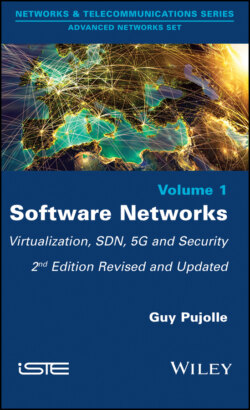Читать книгу Software Networks - Guy Pujolle - Страница 20
1.4. Software networks
ОглавлениеSoftware networks have numerous properties that are novel in comparison to hardware networks. To begin with, we can easily move virtual machines around, because they are simply programs. Thus, we can migrate a router from one physical node to another. Migration may occur when a physical node begins to fail, or when a node is overloaded, or for any other reason decided on in advance. Migration of a node does not actually involve transporting the whole of the code for the machine, which would, in certain cases, be rather cumbersome and time-consuming. In general, the program needing to be migrated is already present in the remote node, but it is idle. Therefore, we merely need to begin running the program and send it the configuration of the node to be moved. This requires the transmission of relatively little data, so the latency before the migrated machine starts up is short. In general, we can even let both machines run at once, and change the routing so that the data only flow through the migrated node. We can then shut down the first router.
More generally, we carry out what is known as urbanization: we migrate the virtual machines to different physical machines until we obtain optimal performance. Urbanization is greatly used for optimization in terms of energy consumption or workload distribution, as well as to optimize the cost of the software networks or to make the network highly reliable or resilient. For example, in order to optimize energy consumption, we need to bring together the virtual machines on shared nodes and switch off all the nodes that are no longer active. In actual fact, these machines would not be shut down but rather placed on standby, which does still consume a small amount of energy, but only a very small amount. The major difficulty with urbanization arises when it is necessary to optimize all operational criteria at the same time because they are often incompatible – for example, optimizing consumption and performance at the same time.
A very important characteristic mentioned earlier is isolation: the software networks must be isolated from one another, so that an attack on one network does not affect the other networks. Isolation is complex, because simultaneously, we need to share the common resources and be sure that, at all times, each network has access to its own resources, negotiated at the time of establishment of the software network. In general, a token-based algorithm is used. Every virtual device on every software network receives tokens according to the resources attributed to it. For example, for a physical node, ten tokens might be distributed to network 1, five tokens to network 2 and one token to network 3. The networks spend their tokens on the basis of certain tasks performed, such as the transmission of n bytes. At all times, each device can have its own tokens and thus have a minimum data rate determined when the resources were allocated. However, a problem arises if a network does not have packets to send, because then it does not spend its tokens. A network may have all of its tokens when the other networks have already spent all of theirs. In this case, so as not to immobilize the system, we allocate negative tokens to the other two networks, which can then surpass the usage rate defined when their resources were allocated. When the sum of the remaining tokens less the negative tokens is equal to zero, then the machine’s basic tokens are redistributed. This enables us to maintain isolation while still sharing the hardware resources. In addition, we can attach a certain priority to a software network while preserving the isolation, by allowing that particular network to spend its tokens as a matter of priority over the other networks. This is relative priority, because each network can, at any moment, recoup its basic resources. However, the priority can be accentuated by distributing any excess resources to the priority networks, which will then always have a token available to handle a packet. Of course, isolation requires other characteristics of the hypervisors and the virtualization techniques, which we will not discuss in this book.
Virtualization needs to be linked to other features in order to fully make sense. SDN (Software-Defined Networking) is one of the paradigms strongly linked to virtualization, because it involves the uncoupling of the physical part from the control part. The control part can be virtualized and deported onto another machine, which enables us, for example, to have both a far great processing power than that of the original machine and also a much larger memory available.
